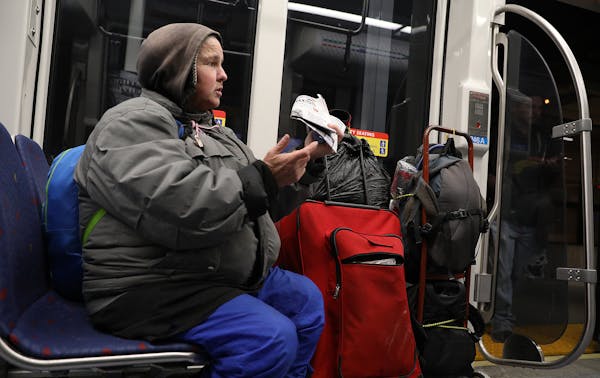As temperatures dip, the number of homeless people seeking temporary shelter on Metro Transit trains and buses goes up, too.
In the summer, about 200 people sleep on both the Blue and Green light-rail lines every night, but that figure inevitably surges to more than 350 nightly during the winter, according to Metro Transit Police Chief John Harrington.
It's a conundrum facing transit agencies nationwide — and one with no easy fix. "We are not going to arrest our way out of the problem," Harrington said at a Metropolitan Council meeting Wednesday.
The regional planning body and its police force will continue to partner with local social service agencies to assist homeless passengers — a strategy that he says works "reasonably well."
The council has also named a point person who will create a registry of homeless people using transit for shelter and issue federal housing vouchers. This will help prevent duplication of services, said Terri Smith, director of the council's Housing and Redevelopment Authority, who is leading the effort.
Metro Transit has been "buried" with consumer complaints in recent years regarding homeless people on trains and buses, and the pace of these calls is increasing, Harrington said. In 2015, the transit provider received 1,273 calls regarding people sleeping on trains, but that number could reach 3,500 this year, he added.
The safety of passengers, including the homeless, and train and bus operators concerns police, as well.
A light-rail operator was attacked with a box cutter after telling so-called "sleepers" to leave the train one evening, Harrington said. Passengers have been robbed and assaulted aboard trains. And recently, three homeless women reported being raped on transit platforms, he said.
"This speaks to the problem: If you ask people why they're sleeping on the train, a lot of them will say it's safe," he said. "We're often the last resort."
Sleeping on trains and buses is not illegal, and police have said the vast majority of those who do so pay their fares. Metro Transit offers discounted fares to organizations that assist those experiencing homelessness.
The issue of homeless passengers seeking refuge on public transit has vexed transit providers for decades. "If you ask transit police chiefs their No. 1 concern, they'll say [the homeless issue] is it," Harrington said.
Other transit agencies are trying similar outreach programs. The Metropolitan Transportation Authority in Los Angeles has increased spending on law enforcement and security by 40 percent and deployed social workers on the subway's Red Line, according to media reports.
Overall, successful policies "target behavior rather than groups of individuals," said a 2016 study by the federal Transit Cooperative Research Program. Partnerships "are essential and enforcement is necessary, but not sufficient," according to the study. The research was based on surveys completed by transit agencies across the country, including Metro Transit.
"People who are homeless are often incorrectly viewed as a homogeneous group," the study concludes. "Case workers and others at social service and nonprofit agencies have a much greater understanding of people who are homeless and they can persuade these individuals, who may initially be service-resistant, to accept services."
For regular transit riders, the presence of homeless people sleeping on trains (and occasionally on buses) comes as no surprise.
Mark Snyder, who lives in northeast Minneapolis and commutes to work by bus and the Green Line, said via Twitter: "As long as they leave the rest of us alone, I'm fine with it." Others on Twitter pointed out that rowdy behavior on transit typically doesn't involve homeless people.
Project 2025 platform proposal aims to allow mining in Boundary Waters watershed

Ann Johnson Stewart wins special election, giving DFL control of Minnesota Senate

Democratic U.S. Sen. Amy Klobuchar defeats GOP challenger Royce White

Gov. Tim Walz will return to Minnesota after Trump victory blocks him from becoming vice president

